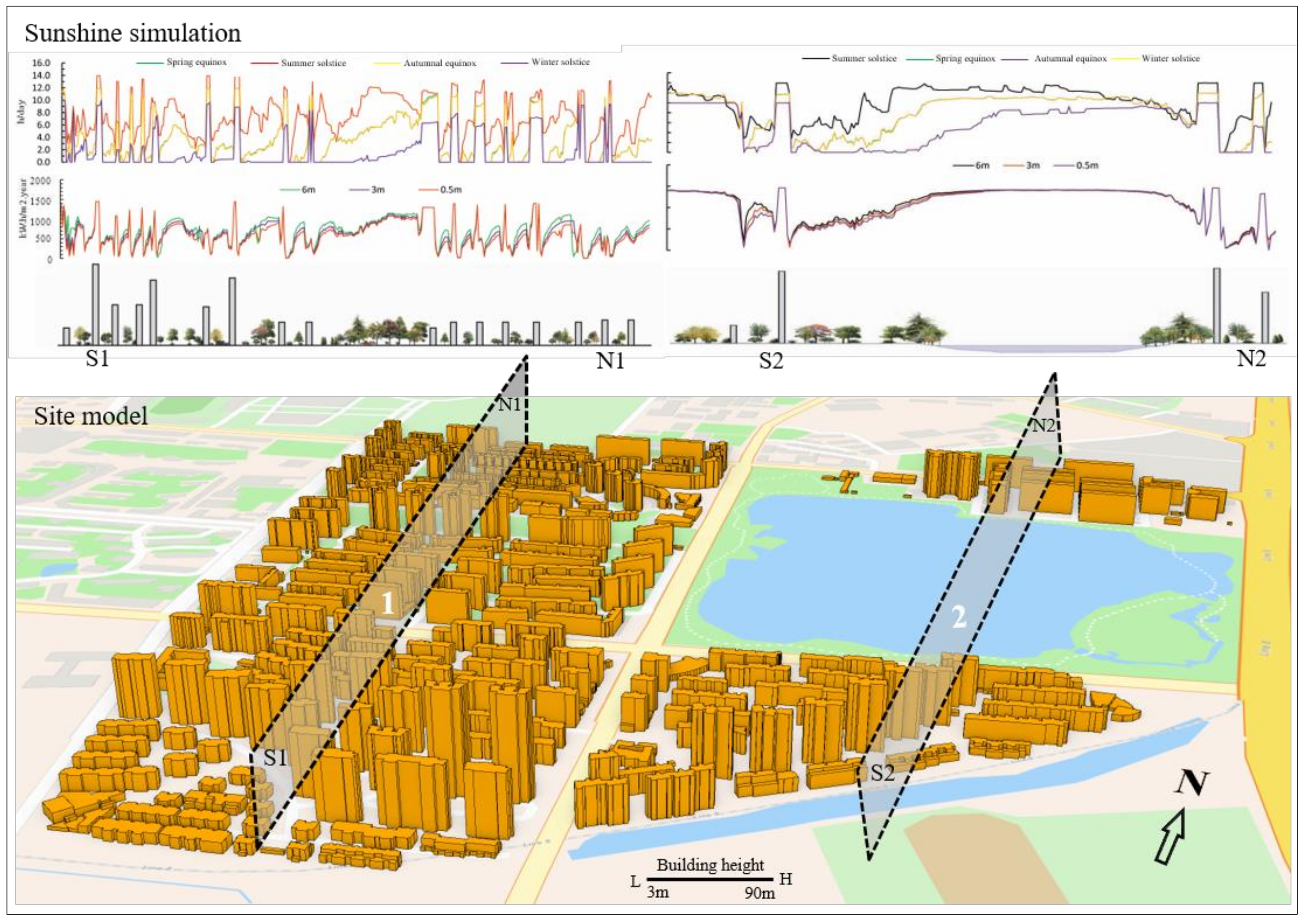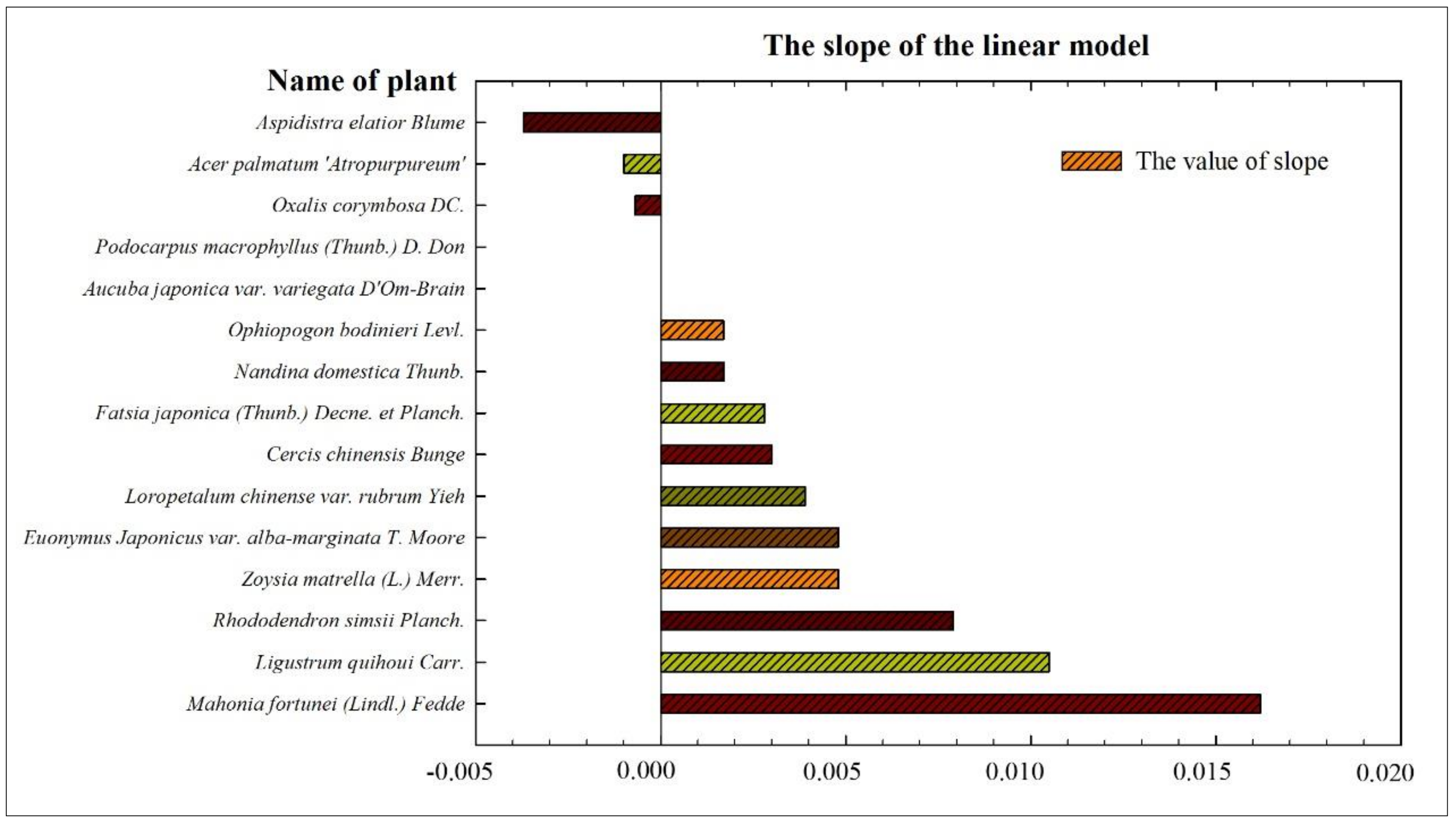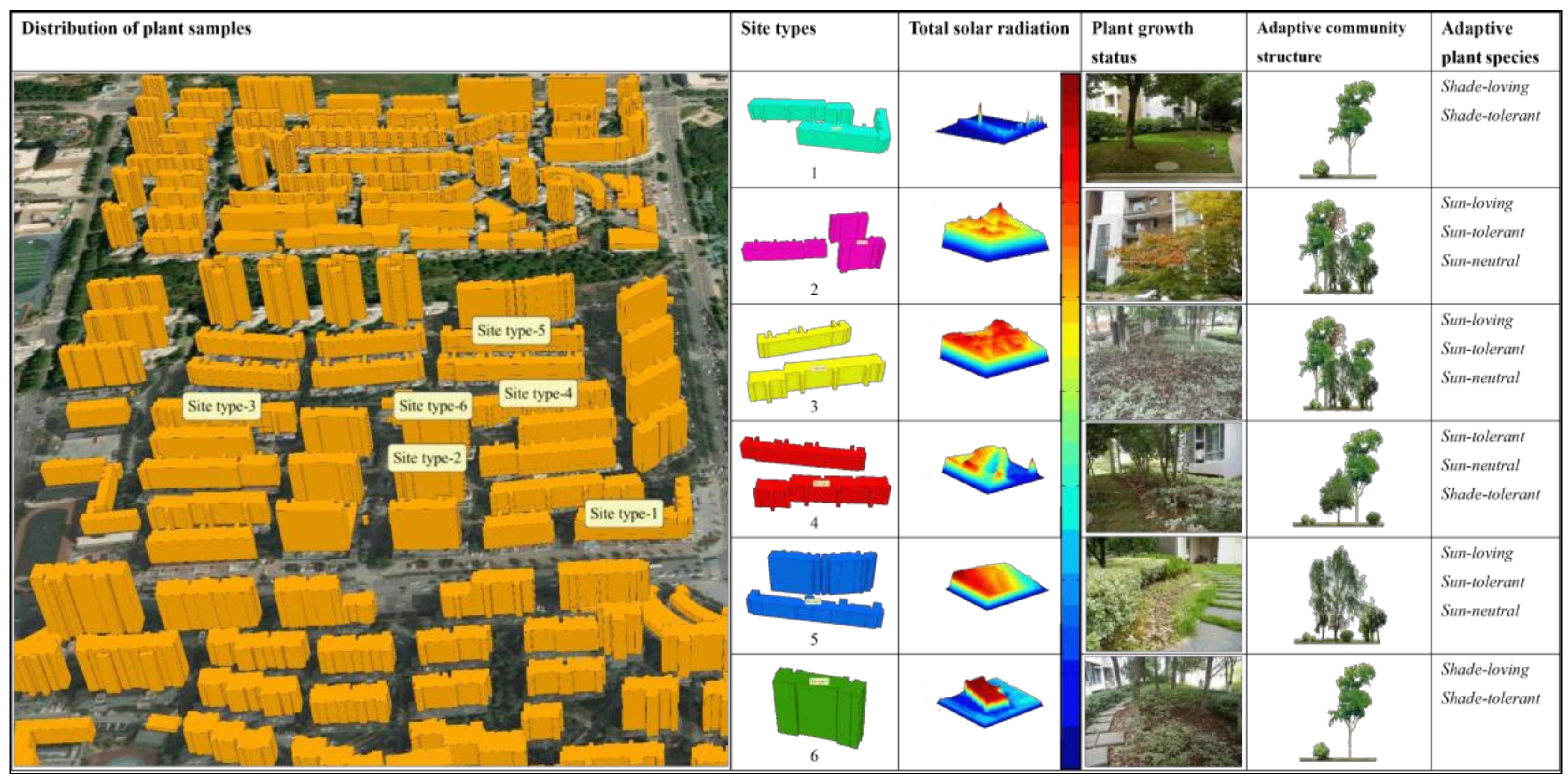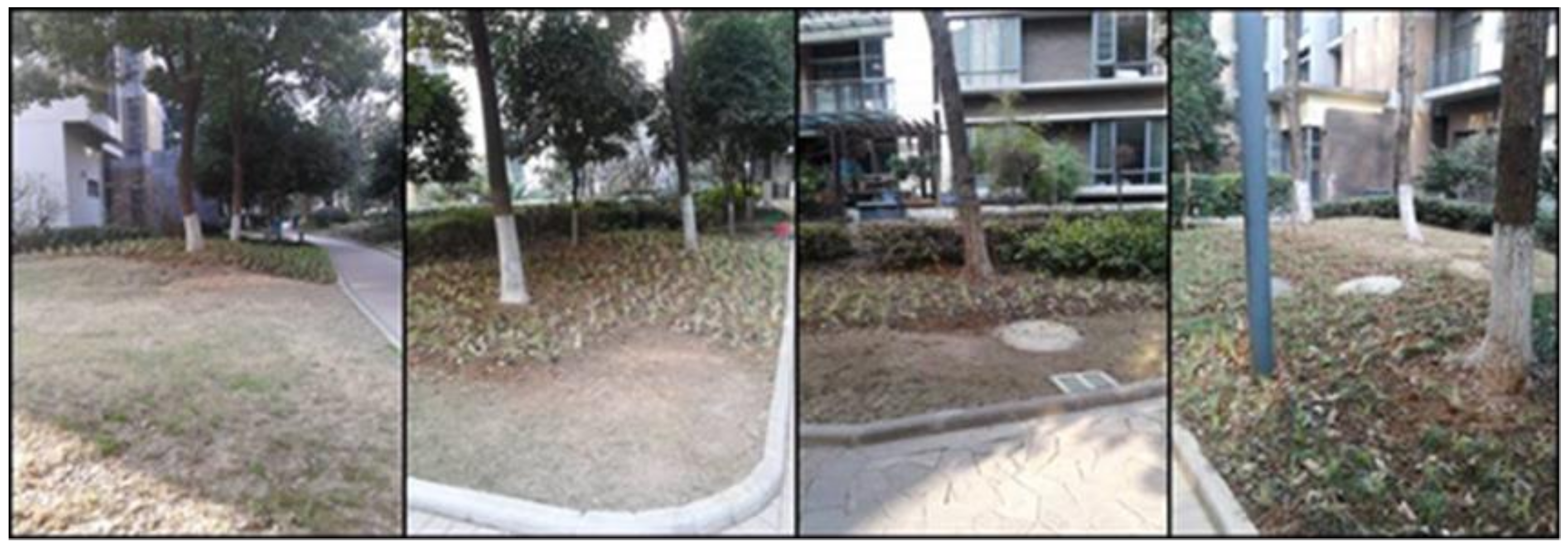A Digital Framework to Predict the Sunshine Requirements of Landscape Plants
Abstract
1. Introduction
- A plant will show different health responses under different conditions of solar radiation, if the other ecological factors remain the same.
- If properly calibrated, digital technology can be used to accurately simulate solar radiation.
- If the preconditions are true, two-factor linear fitting between the plant health response and solar radiation can be used to obtain the healthy, sub-healthy, and unhealthy levels of landscape plants.
2. Materials and Methodology
2.1. Digital Framework
2.1.1. Structure and Workflow of the Digital Framework
2.1.2. Solar Radiation Simulation and Correction
2.1.3. Health Criteria to Determine the State of Plant Growth
2.1.4. Data Fitting and Predictive Analysis
2.2. Study Area and Location
2.3. Plant Samples and Data Management
2.4. Equipment, Instruments, and Techniques Used in the Study
3. Results and Discussion
3.1. Plant Health Level Response to Solar Radiation
3.2. Plant Sensitivity to the Changes of Solar Radiation
3.3. Accuracy Analysis of the Forecasting Framework
4. Conclusions and Outlook
Supplementary Materials
Author Contributions
Funding
Institutional Review Board Statement
Informed Consent Statement
Data Availability Statement
Acknowledgments
Conflicts of Interest
References
- United Nations. World Population Prospects 2019. In Population Division; United Nations: New York, NY, USA, 2019. [Google Scholar]
- Zhou, X.; Wang, Y.-C. Spatial–temporal dynamics of urban green space in response to rapid urbanization and greening policies. Landsc. Urban Plan. 2011, 100, 268–277. [Google Scholar] [CrossRef]
- Wolch, J.R.; Byrne, J.; Newell, J.P. Urban green space, public health, and environmental justice: The challenge of making cities ‘just green enough’. Landsc. Urban Plan. 2014, 125, 234–244. [Google Scholar] [CrossRef]
- Kumar, M.; Gogoi, A.; Kumari, D.; Borah, R.; Das, P.; Mazumder, P.; Tyagi, V.K. Review of Perspective, Problems, Challenges, and Future Scenario of Metal Contami-nation in the Urban Environment. J. Hazard. Toxic Radioact. Waste 2017, 21, 04017007. [Google Scholar] [CrossRef]
- Rahman, M.M.; Haughton, G.; Jonas, A.E.G. The challenges of local environmental problems facing the urban poor in Chit-tagong, Bangladesh: A scale-sensitive analysis. Environ. Urban. 2010, 22, 561–578. [Google Scholar] [CrossRef]
- Zevenbergen, C.; Fu, D.; Pathirana, A. Transitioning to Sponge Cities: Challenges and Opportunities to Address Urban Water Problems in China. Water 2018, 10, 1230. [Google Scholar] [CrossRef]
- Teng, M.; Wu, C.; Zhou, Z.; Lord, E.; Zheng, Z. Multipurpose greenway planning for changing cities: A framework integrating priorities and a least-cost path model. Landsc. Urban Plan. 2011, 103, 1–14. [Google Scholar] [CrossRef]
- Filazzola, A.; Shrestha, N.; MacIvor, J.S. The contribution of constructed green infrastructure to urban biodiversity: A synthesis and meta-analysis. J. Appl. Ecol. 2019, 56, 2131–2143. [Google Scholar] [CrossRef]
- Erell, E. Urban Greening and Microclimate Modification. In Greening Cities; Springer: Singapore, 2017; pp. 73–93. [Google Scholar] [CrossRef]
- Duarte, D.H.; Shinzato, P.; Gusson, C.D.S.; Alves, C.A. The impact of vegetation on urban microclimate to counterbalance built density in a subtropical changing climate. Urban Clim. 2015, 14, 224–239. [Google Scholar] [CrossRef]
- Ferrini, F.; Fini, A.; Mori, J.; Gori, A. Role of Vegetation as a Mitigating Factor in the Urban Context. Sustainability 2020, 12, 4247. [Google Scholar] [CrossRef]
- Yli-Pelkonen, V.; Scott, A.A.; Viippola, V.; Setälä, H. Trees in urban parks and forests reduce O3, but not NO2 concentrations in Baltimore, MD, USA. Atmos. Environ. 2017, 167, 73–80. [Google Scholar] [CrossRef]
- Wang, X.; Teng, M.; Huang, C.; Zhou, Z.; Chen, X.; Xiang, Y. Canopy density effects on particulate matter attenuation coefficients in street canyons during summer in the Wuhan metropolitan area. Atmos. Environ. 2020, 240, 117739. [Google Scholar] [CrossRef]
- Chen, B.; Adimo, O.A.; Bao, Z. Assessment of aesthetic quality and multiple functions of urban green space from the users’ perspective: The case of Hangzhou Flower Garden, China. Landsc. Urban Plan. 2009, 93, 76–82. [Google Scholar] [CrossRef]
- Astell-Burt, T.; Feng, X.; Kolt, G.S. Mental health benefits of neighbourhood green space are stronger among physically active adults in middle-to-older age: Evidence from 260,061 Australians. Prev. Med. 2013, 57, 601–606. [Google Scholar] [CrossRef]
- Wan, C.; Shen, G.Q.; Choi, S. Effects of physical and psychological factors on users’ attitudes, use patterns, and perceived benefits toward urban parks. Urban For. Urban Green. 2020, 51, 126691. [Google Scholar] [CrossRef]
- Monteiro, M.V.; Handley, P.; Doick, K.J. An insight to the current state and sustainability of urban forests across Great Britain based on i-Tree Eco surveys. Forestry 2019, 93, 107–123. [Google Scholar] [CrossRef]
- Duinker, P.N.; Ordóñez, C.; Steenberg, J.W.N.; Miller, K.H.; Toni, S.A.; Nitoslawski, S.A. Trees in Canadian Cities: Indispensable Life Form for Urban Sustainability. Sustainability 2015, 7, 7379–7396. [Google Scholar] [CrossRef]
- Kirnbauer, M.C.; Kenney, W.A.; Churchill, C.J.; Baetz, B.W. A prototype decision support system for sustainable urban tree planting pro-grams. Urban For. Urban Green. 2009, 8, 3–19. [Google Scholar] [CrossRef]
- Wei, H.; Huang, Z. From Experience-Oriented to Quantity-Based: A Method for Landscape Plant Selection and Configuration in Urban Built-Up Areas. J. Sustain. For. 2015, 34, 698–719. [Google Scholar] [CrossRef]
- Wei, H.; Huang, Z.; Lin, M. A Decision Support System for Plant Optimization in Urban Areas with Diversified Solar Radiation. Sustainability 2017, 9, 215. [Google Scholar] [CrossRef]
- Minckler, L.S. The right tree in the right place. J. For. 1941, 39, 685–688. [Google Scholar]
- Bassuk, N. Recommended Urban Trees: Site Assessment and Tree Selection for Stress Tolerance; Cornell University, Urban Horticulture Institute: Ithaca, NY, USA, 2003. [Google Scholar]
- Sæbø, A.; Benedikz, T.; Randrup, T.B. Selection of trees for urban forestry in the Nordic countries. Urban For. Urban Green. 2003, 2, 101–114. [Google Scholar] [CrossRef]
- Sæbø, A.; Borzan, Ž.; Ducatillion, C.; Hatzistathis, A.; Lagerström, T.; Supuka, J.; Garcia-Valdecantos, J.L.; Rego, F.; Van Slycken, J. The Selection of Plant Materials for Street Trees, Park Trees and Urban Woodland. In Urban Forests and Trees; Springer: Berlin/Heidelberg, Germany, 2005; pp. 257–280. [Google Scholar] [CrossRef]
- Fini, A.; Ferrini, F.; Di Ferdinando, M.; Brunetti, C.; Giordano, C.; Gerini, F.; Tattini, M. Acclimation to partial shading or full sunlight determines the performance of container-grown Fraxinus ornus to subsequent drought stress. Urban For. Urban Green. 2014, 13, 63–70. [Google Scholar] [CrossRef]
- Fini, A.; Frangi, P.; Mori, J.; Donzelli, D.; Ferrini, F. Nature based solutions to mitigate soil sealing in urban areas: Results from a 4-year study comparing permeable, porous, and impermeable pavements. Environ. Res. 2017, 156, 443–454. [Google Scholar] [CrossRef]
- SULIS. Selecting Plants for an Upper Midwest Landscape. Available online: https://www.extension.umn.edu/garden/landscaping/plant/ (accessed on 25 February 2021).
- Hansen, S.M.; Gunnell, J.; Whaley, A.; Dai, X.; Harding, C.; Black, B.L. Adaptability of Tree Species as Windbreaks for Urban Farms in the US Inter-mountain West. Horticulturae 2020, 6, 17. [Google Scholar] [CrossRef]
- Wilson, M. Smart Trees and Shrubs Suitable for Michigan Landscapes. Available online: https://www.canr.msu.edu/news/smart_trees_and_shrubs_for_michigan_landscapes (accessed on 25 February 2021).
- Yu, B.; Liu, H.; Wu, J.; Lin, W.-M. Investigating impacts of urban morphology on spatio-temporal variations of solar radiation with airborne LIDAR data and a solar flux model: A case study of downtown Houston. Int. J. Remote Sens. 2009, 30, 4359–4385. [Google Scholar] [CrossRef]
- Vogt, J.; Gillner, S.; Hofmann, M.; Tharang, A.; Dettmann, S.; Gerstenberg, T.; Schmidt, C.; Gebauer, H.; Van De Riet, K.; Berger, U.; et al. Citree: A database supporting tree selection for urban areas in temperate climate. Landsc. Urban Plan. 2017, 157, 14–25. [Google Scholar] [CrossRef]
- Grant, S. The Right Tree in the Right Place: Using GIS to Maximize the Net Benefits from Urban Forests. Master’s Thesis, Lunds Universitet, Lund, Sweden, 2016. [Google Scholar]
- Ishida, A.; Nakano, T.; Matsumoto, Y.; Sakoda, M.; Ang, L.H. Diurnal changes in leaf gas exchange and chlorophyll fluorescence in tropical tree species with contrasting light requirements. Ecol. Res. 1999, 14, 77–88. [Google Scholar] [CrossRef]
- Toledo-Aceves, T.; Swaine, M.D. Biomass allocation and photosynthetic responses of lianas and pioneer tree seedlings to light. Acta Oecol. 2008, 34, 38–49. [Google Scholar] [CrossRef]
- Diekmann, M. Ecological behaviour of deciduous hardwood trees in Boreo-nemoral Sweden in relation to light and soil con-ditions. For. Ecol. Manag. 1996, 86, 1–14. [Google Scholar] [CrossRef]
- Carter, R.; Klinka, K. Variation in shade tolerance of Douglas fir, western hemlock, and western red cedar in coastal British Columbia. For. Ecol. Manag. 1992, 55, 87–105. [Google Scholar] [CrossRef]
- Henry, H.A.L.; Aarssen, L.W. Inter- and intraspecific relationships between shade tolerance and shade avoidance in temperate trees. Oikos 2001, 93, 477–487. [Google Scholar] [CrossRef]
- Huang, D.; Wu, L.; Chen, J.R.; Dong, L. Morphological plasticity, photosynthesis and chlorophyll fluorescence of Athyrium pachyphlebium at different shade levels. Photosynthetica 2011, 49, 611–618. [Google Scholar] [CrossRef]
- Zhao, D.; Hao, Z.; Tao, J. Effects of shade on plant growth and flower quality in the herbaceous peony (Paeonia lactiflora Pall.). Plant Physiol. Biochem. 2012, 61, 187–196. [Google Scholar] [CrossRef] [PubMed]
- Wang, Y.; Ma, W. Comparative studies on light utilization characteristics and shade tolerance of 7 climbing shrub species. For. Res. 2004, 17, 305–308. [Google Scholar]
- Qi, X.X.; Jiang, Y.S.; Wei, X.; Tang, H.; Xiong, Z.C.; Ye, W.H.; Wang, Z.M. Photosynthetic Characteristic of an Endangered Species Camellia Nitidissima and Its Con-servation Implications. Pakistan. J. Bot. 2012, 44, 327–331. [Google Scholar]
- Lin, S.; Zhang, Q.; Chen, Q. Shade-tolerance of ten species of garden plants. J. Northeast For. Univ. 2007, 35, 32–34. [Google Scholar]
- Yin, L. Research of Shaded Green Space Landscape Based on Natural Light Environment under the Urban Viaducts—Case Study on Viaducts in Wuhan City; Huazhong University of Science and Technology: Wuhan, China, 2012. [Google Scholar]
- Xia, L. Study on Eco-Photosynthetic Characteristics and Ecological Effects of Common Landscape Plants in Chongqing, China; SouthWest University: Chongqing, China, 2011. [Google Scholar]
- Chen, Y.; Liao, J.; Qin, S. Studies on photosynthetic characteristics and carbon fixation and oxygen release capabilities of 19 garden plants in Changsha area. J. Cent. S. Univ. For. Technol. 2012, 10, 116–120. [Google Scholar]
- Kambezidis, H.D.; Adamopoulos, A.D.; Sakellariou, N.K.; Pavlopoulos, H.G.; Aguiar, R.; Bilbao, J.; de Miguel, A.; Negro, E. The “Meteorological Radiation Model”. Mech.-Electr. Eng. 1998, 3, 38–42. [Google Scholar]
- Kambezidis, H.; Psiloglou, B.; Karagiannis, D.; Dumka, U.; Kaskaoutis, D. Recent improvements of the Meteorological Radiation Model for solar irradiance estimates under all-sky conditions. Renew. Energy 2016, 93, 142–158. [Google Scholar] [CrossRef]
- Kambezidis, H.D. Solar Radiation Modelling: The Latest Version and Capabilities of MRM. J. Fundam. Renew. Energy Appl. 2017, 7. [Google Scholar] [CrossRef]
- Kambezidis, H.D. The solar radiation climate of Athens: Variations and tendencies in the period 1992–2017, the brightening era. Sol. Energy 2018, 173, 328–347. [Google Scholar] [CrossRef]
- Kambezidis, H.D.; Psiloglou, B.E.; Kaskaoutis, D.G.; Karagiannis, D.; Petrinoli, K.; Gavriil, A.; Kavadias, K. Generation of typical meteorological years for 33 locations in Greece: Adaptation to the needs of various applications. Theor. Appl. Clim. 2020, 141, 1313–1330. [Google Scholar] [CrossRef]
- Kambezidis, H.D. Climate Change and Thermal Comfort in Greece. Climate 2021, 9, 10. [Google Scholar] [CrossRef]
- Kambezidis, H.D.; Psiloglou, B.E.; Kavadias, K.A.; Paliatsos, A.G.; Bartzokas, A. Development of a Greek solar map based on solar model estimations. Sun Geosph. 2016, 11, 137–141. [Google Scholar]
- Radosevic, N.; Duckham, M.; Liu, G.J.; Sun, Q. Solar radiation modeling with KNIME and Solar Analyst: Increasing environ-mental model reproducibility using scientific workflows. Environ. Model. Softw. 2020, 132, 104780. [Google Scholar] [CrossRef]
- Chow, A.; Fung, A.S.; Li, S. GIS Modeling of Solar Neighborhood Potential at a Fine Spatiotemporal Resolution. Buildings 2014, 4, 195–206. [Google Scholar] [CrossRef]
- Peitsman, H.C.; Bakker, V.E. Application of Black-Box Models to HVAC Systems for Fault Detection; American Society of Heating, Refrigerating and Air-Conditioning Engineers: Atlanta, GA, USA, 1996. [Google Scholar]
- Ljung, L. Black-box models from input-output measurements. In Proceedings of the 18th IEEE instrumentation and measurement technology conference, Budapest, Hungary, 21–23 May 2001; Volume 1, pp. 138–146. [Google Scholar] [CrossRef]
- Huang, S.; Fu, P. Modeling Small Areas Is a Big Challenge. ESRI ArcUser 2009, 2831, 2013. [Google Scholar]
- Fu, P.; Rich, P.M. Design and implementation of the Solar Analyst: An ArcView extension for modeling solar radiation at landscape scales. In Proceedings of the Nineteenth Annual ESRI User Conference, San Diego, CA, USA; 1999; pp. 1–31. [Google Scholar]
- Environmental Growth Chambers. Lighting Radiation Conversion. Available online: http://www.egc.com/useful_info_lighting.php (accessed on 25 February 2021).
- Liu, Y. Assessment on Ancient Trees Health on Basis of Morphological Characteristics in Beijing; Beijing Forestry University: Beijing, China, 2013. [Google Scholar]
- Chen, J. Health Assessment of Ancient Trees in Beijing; Beijing Forestry University: Beijing, China, 2014. [Google Scholar]
- Bond, J. Urban Tree Health: A Practical and Precise Estimation Method; Urban Forest Analytics LLC: Geneva, NY, USA, 2012. [Google Scholar]
- Winn, M.F.; Lee, S.-M.; Araman, P.A. Urban tree crown health assessment system: A tool for communities and citizen foresters. In Proceedings of the Emerging Issues Along Urban-Rural Interfaces II: Linking Land-Use Science and Society, Atlanta, GA, USA, 9–12 April 2007; pp. 180–183. [Google Scholar]
- Mattheck, C.; Breloer, H. Field guide for visual tree assessment (VTA). Arboric. J. 1994, 18, 1–23. [Google Scholar] [CrossRef]
- Chen, M.; Fu, H. A study on the environment of the viaduct shadow and its influence on the plant growth. Chin. Landsc. Archit. 2006, 09, 68–72. [Google Scholar]
- Bianculli, M.L.; Aguirrezábal, L.A.; Irujo, G.A.P.; Echarte, M.M. Contribution of incident solar radiation on leaves and pods to soybean seed weight and composition. Eur. J. Agron. 2016, 77, 1–9. [Google Scholar] [CrossRef]
- Díaz-Pérez, J.C. Bell Pepper (Capsicum annum L.) Crop as Affected by Shade Level: Microenvironment, Plant Growth, Leaf Gas Exchange, and Leaf Mineral Nutrient Concentration. HortScience 2013, 48, 175–182. [Google Scholar] [CrossRef]
- Cope, T.; Gray, A. Grasses of the British Isles; Botanical Society of the British Isles: London, UK, 2009; pp. 18–19. [Google Scholar]
- Kephart, K.D.; Buxton, D.R.; Taylor, S.E. Growth of C3 and C4 Perennial Grasses under Reduced Irradiance. Crop Sci. 1992, 32, 1033–1038. [Google Scholar] [CrossRef]
- Kephart, K.D.; Buxton, D.R. Forage Quality Responses of C3 and C4 Perennial Grasses to Shade. Crop Sci. 1993, 33, 831–837. [Google Scholar] [CrossRef]
- Wei, H. An Intelligent Decision-Making Method for Landscape Plant Selection Based on Their Habits of Sunshine Requirements; Wuhan University: Wuhan, China, 2016. [Google Scholar]
- Wei, H.; Liu, X.; Chen, X.; Liu, J.; Zhang, G. The Urban Environment with Diversified Solar Radiation and Adaptive Planning Strategies for Landscap Plants. J. Jiangxi Norm. Univ. 2019, 43, 433–440. [Google Scholar]
- Wei, H.; Huang, Z.; Liu, X. UP-DSS: A Decision Support System for Landscape Plant Selection and Community Configuration Based on Sunshine Adaptability. J. Jianghan Univ. 2019, 47, 258–264. [Google Scholar]
- Youssef, A.; Mady, M. Influence of light intensity and benzyladenine on growth performance of Aspidistra elatior Blume plant. Res. J. Agric. Biol. Sci. 2013, 9, 248–257. [Google Scholar]
- Stamps, R.H. Effects of Shade Level and Fertilizer Rate on Yield and Vase Life of Aspidistra elatior ‘Variegata’ Leaves. J. Environ. Hortic. 1995, 13, 137–139. [Google Scholar] [CrossRef]
- Stamps, R.; Chandler, A. International Symposium on Cultivation and Utilization of Asian; ISHS: Seoul, Korea, 2006; pp. 169–176. [Google Scholar]
- Trappe, J.M.; Karcher, D.E.; Richardson, M.D.; Patton, A.J. Shade and Traffic Tolerance Varies for Bermudagrass and Zoysiagrass Cultivars. Crop Sci. 2011, 51, 870–877. [Google Scholar] [CrossRef]
- Sladek, B.S.; Henry, G.M.; Auld, D.L. Evaluation of Zoysiagrass Genotypes for Shade Tolerance. HortScience 2009, 44, 1447–1451. [Google Scholar] [CrossRef]
- Raveh, E.; Wang, N.; Nobel, P.S. Gas exchange and metabolite fluctuations in green and yellow bands of variegated leaves of the monocotyledonous CAM species Agave americana. Physiol. Plant. 1998, 103, 99–106. [Google Scholar] [CrossRef]
- Zhang, Q.; Zhang, M.; Ding, Y.; Zhou, P.; Fang, Y. Composition of photosynthetic pigments and photosynthetic characteristics in green and yellow sectors of the variegated Aucuba japonica ‘Variegata’ leaves. Flora—Morphol. Distrib. Funct. Ecol. Plants 2018, 240, 25–33. [Google Scholar] [CrossRef]








| Name | Description | Name | Description |
|---|---|---|---|
| Slope/aspect | Flat surface | Building height | N * 3.3 m |
| Time period | 2014 (whole year/average daily) | Building grid size | 0.5 * 0.5 |
| Latitude | 30.5° N | Transmittance | 0.5 |
| Sky size | 200 * 200 | Hour interval | 0.5 |
| Proportion of diffuse radiation | 0.3 | Calculation directions | 32 |
| Method | Indicator | Health Levels | Description | ||
|---|---|---|---|---|---|
| Healthy (H) | Sub-Healthy (S-H) | Unhealthy (U-H) | |||
| Appearance judgment | Leaf color | Normal | Yellowed (parts of colorful plants turn green) | Brown (for the growing season) | Experience-based judgment |
| Dead branch rate (DBR) | DBR ≤ 30% | 30% < DBR ≤ 50% | DBR > 50% | Quantitative calculation | |
| Comprehensive status of plant growth (CSPG) | ExuberSant | Weak | Very weak or withered | Experience-based judgment | |
| Soil exposure level (SEL) | SEL ≤ 10% | 10% < SEL ≤ 50% | SEL > 50% | Quantitative calculation | |
| Physiological tests | Photosynthetic rate (PR) | PR ± normal value × 10% | PR ≥ normal value × 50% | PR < normal value × 50% | Quantitative calculation |
| Chlorophyll content (CC) | CC ± normal value × 10% | CC ≥ normal value × 50% | CC < normal value × 50% | Quantitative calculation | |
| Other | Leaf area index (LAI) | LAI ≥ normal value × 90% | Normal value * 90% < LAI ≤ normal value × 50% | LAI < normal value × 50% | Quantitative calculation |
| Scientific Name of the Plant Samples (Latin Name) | Number of Samples | Features | ||||
|---|---|---|---|---|---|---|
| Type-1 | Type-2 | |||||
| Tree | Shrub | Ground-Cover Plant | Evergreen | Deciduous | ||
| Cercis chinensis Bunge | 7 | × | × | |||
| Podocarpus macrophyllus (Thunb.) D. Don | 5 | × | × | |||
| Acer palmatum ‘Atropurpureum’ | 6 | × | × | |||
| Aucuba japonica var. variegata D’Om-Brain | 8 | × | × | |||
| Fatsia japonica (Thunb.) Decne. et Planch. | 8 | × | × | |||
| Mahonia fortunei (Lindl.) Fedde | 8 | × | × | |||
| Nandina domestica Thunb. | 6 | × | × | |||
| Ligustrum quihoui Carr. | 16 | × | × | |||
| Rhododendron simsii Planch. | 19 | × | × | |||
| Loropetalum chinense var. rubrum Yieh | 14 | × | × | |||
| Euonymus japonicus var. alba-marginata T. Moore | 14 | × | × | |||
| Aspidistra elatior Blume | 7 | × | × | |||
| Ophiopogon bodinieri Levl. | 19 | × | × | |||
| Oxalis corymbosa DC. | 8 | × | × | |||
| Zoysia matrella (L.) Merr. | 25 | × | × | |||
| Function | Specific Name |
|---|---|
| · Recording and drawing | · Sample survey form, image maps of the study area |
| · Image acquisition | · Digital camera (Nikon COOLPIX S8100), smartphone |
| · Measurement and analysis of physiological indices | · LI-6400XT Portable Photosynthetic System (Li-Cor Inc.) · SPAD 502 Plus Chlorophyll Meter |
| · Measurement of environmental light | · LightScout Quantum Meter (Spectrum Technologies USA Inc., model: QMSS-S) |
| · Simulation and analysis of solar radiation | · Solar Analyst model, ArcGIS 10.2 for desktop, ESRI. |
| · Distance measurement and parameter correction | · Total station · Tape measure |
| Scientific Name of Plant | LCP (μmole/m2·s) | Data of this Research [72] | ||||
|---|---|---|---|---|---|---|
| Data-1 [44] Wuhan | Data-2 [46] Changsha | Data-3 [43] Nanjing | Data-4 [45] Chongqing | Sub-Healthy | Healthy | |
| Fatsia japonica (Thunb.) Decne. et Planch. | 8.91 | 8 | --- | --- | 11 | 38 |
| Loropetalum chinense var. rubrum Yieh | --- | 8 | 23 | 27.3 | 40 | 120 |
| Rhododendron simsii Planch. | 22.97 | 16 | --- | 32.27 | 49 | 153 |
| Euonymus japonicus var. alba-marginata T. Moore | 23 | --- | --- | --- | 144 | 295 |
| Nandina domestica Thunb. | 17.68 | --- | --- | --- | 10 | 38 |
| Mahonia fortunei (Lindl.) Fedde | 42.29 | --- | --- | --- | 31 | 110 |
| Cercis chinensis Bunge | --- | 31.98 | --- | --- | 48 | 321 |
| Aucuba japonica var. variegata D’Om-Brain | --- | 8 | --- | --- | --- | 9 |
Publisher’s Note: MDPI stays neutral with regard to jurisdictional claims in published maps and institutional affiliations. |
© 2021 by the authors. Licensee MDPI, Basel, Switzerland. This article is an open access article distributed under the terms and conditions of the Creative Commons Attribution (CC BY) license (http://creativecommons.org/licenses/by/4.0/).
Share and Cite
Wei, H.; Jiang, W.; Liu, X.; Huang, B. A Digital Framework to Predict the Sunshine Requirements of Landscape Plants. Appl. Sci. 2021, 11, 2098. https://doi.org/10.3390/app11052098
Wei H, Jiang W, Liu X, Huang B. A Digital Framework to Predict the Sunshine Requirements of Landscape Plants. Applied Sciences. 2021; 11(5):2098. https://doi.org/10.3390/app11052098
Chicago/Turabian StyleWei, Heyi, Wenhua Jiang, Xuejun Liu, and Bo Huang. 2021. "A Digital Framework to Predict the Sunshine Requirements of Landscape Plants" Applied Sciences 11, no. 5: 2098. https://doi.org/10.3390/app11052098
APA StyleWei, H., Jiang, W., Liu, X., & Huang, B. (2021). A Digital Framework to Predict the Sunshine Requirements of Landscape Plants. Applied Sciences, 11(5), 2098. https://doi.org/10.3390/app11052098







